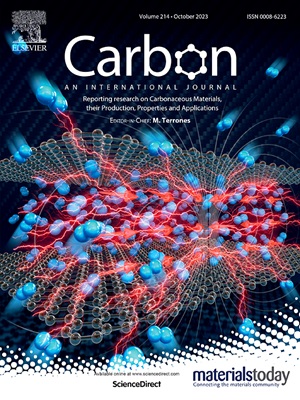Ternary CD/Co3O4@MnCo2O4 heterojunction nanozymes for enhanced sonodynamic/NIR–II–photothermal/nanocatalytic therapy through triple amplification of ROS generation
IF 10.5
2区 材料科学
Q1 CHEMISTRY, PHYSICAL
引用次数: 0
Abstract
The therapeutic potential of nanozyme-based tumor catalytic therapy (NCT) has been widely recognized, yet its efficacy is compromised by the low-efficiency single-component nanozymes and multiple factors within the tumor microenvironment (TME) including adequate levels of H2O2 and overexpressed GSH milieu. Herein, the mild NIR-II hyperthermia and heterojunction fabrication co-augmented NCT strategy are first presented to realize the triple amplification of ROS generation. To demonstrate this concept, a novel ternary heterojunction nanozyme termed CD/Co3O4@MnCo2O4 (CD/CMCO) is successfully constructed through depositing nitrogen-doped carbon dots (CDs) on core-shell structural Co3O4@MnCo2O4 Z-scheme heterojunctions. The formed ternary CD/CMCO heterojunctions could be adopted as a US and NIR-II light double-responsive theranostic nanoplatform for simultaneous sonodynamic/NIR–II–photothermal/nanocatalytic therapy. Notably, the sonodynamic and NIR-II photothermal performances as well as the triple enzyme-like catalytic activities of Co3O4@MnCo2O4 and CDs can be enhanced by the construction of ternary heterojunctions owing to the optimized separation and migration of carriers. More interestingly, CD/CMCO with outstanding NIR-II photothermal characteristics enables the attainment of moderately elevated temperatures (∼43 °C), further amplifying the catalytic activities and then improving ROS generation. The triple cascade amplification of ROS generation is achieved by CD/CMCO with exceptional enzyme-like catalytic activities, which produced more ROS through alleviating hypoxia and consuming GSH. These favorable advantages of CD/CMCO enable it to be a triple ROS generation accelerator for heterojunction and mild NIR-II hyperthermia co-augmented synergistic tumor therapy. This work paves a novel avenue for exploring efficient tumor treatment based on ternary heterojunction nanozymes that are responsive to US and NIR-II light.

求助全文
约1分钟内获得全文
求助全文
来源期刊

Carbon
工程技术-材料科学:综合
CiteScore
20.80
自引率
7.30%
发文量
0
审稿时长
23 days
期刊介绍:
The journal Carbon is an international multidisciplinary forum for communicating scientific advances in the field of carbon materials. It reports new findings related to the formation, structure, properties, behaviors, and technological applications of carbons. Carbons are a broad class of ordered or disordered solid phases composed primarily of elemental carbon, including but not limited to carbon black, carbon fibers and filaments, carbon nanotubes, diamond and diamond-like carbon, fullerenes, glassy carbon, graphite, graphene, graphene-oxide, porous carbons, pyrolytic carbon, and other sp2 and non-sp2 hybridized carbon systems. Carbon is the companion title to the open access journal Carbon Trends. Relevant application areas for carbon materials include biology and medicine, catalysis, electronic, optoelectronic, spintronic, high-frequency, and photonic devices, energy storage and conversion systems, environmental applications and water treatment, smart materials and systems, and structural and thermal applications.
 求助内容:
求助内容: 应助结果提醒方式:
应助结果提醒方式:


